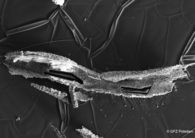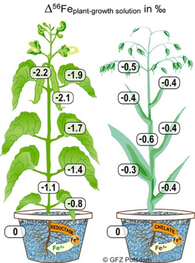Vegetation (plants and fungi) is a key player in liberating and redistributing elements within the Critical Zone. Higher plants, fungi and microorganisms in soil work together to provide and to take up large amounts of nutritive elements (Ca, Mg, K) and micro nutrients (B, Si, Fe, Cu, Zn). Some fraction of the nutrients is made available as plant litter and plant debris are decomposed in soils (recycling), while the remainder will be removed from the ecosystem by a combination of weathering (dissolution) and erosion (mass transport). (Bio) chemical processes taking place during the nutrient uptake and translocation in organisms produce characteristic isotope fractionations, that depend on the metal, its chemical speciation and the pathways taken. These minor shifts in the abundance of stable isotopes (isotope fractionation) may uniquely fingerprint these processes and can be used for identification and quantification.
Using experimental approaches, we calibrate metal(loid) isotope fractionation during the uptake and translocation of Si (in tomato, wheat and mustard), Fe (in oat and beans) and Mg (in the fungus Knufia petricola). To achieve this, the organisms were cultured in controlled lab experiments, and the stable isotope ratios of 26Mg/24Mg (magnesium-26 / magnesium-24), 30Si/28Si (silicon-30 / silicon-28), and 56Fe/54Fe (iron-56 / iron-54) were determined in both the growth solutions and the plants and/or fungi.
Silicon is actively taken up as silicic acid by some plant species to increase their structural stability and develop resistance to environmental stresses, while it is actively excluded from uptake by other species. To explore the underlying mechanisms, we used the stable isotopes of silicon, whose relative abundance shifts depending on the biochemical transformations involved. We observed that in both species with a rejective (tomato, mustard) and in those with an active (wheat) uptake mechanism, silicic acid uptake in is controlled by diffusion and that 28Si is preferentially taken up. The fractionation factors (expressed as 1000×ln(α) [‰]) between the two uptake types are comparable (-0.55±0.40 (mustard), -0.33±0.32 (tomato), and -0.43±0.09 (wheat)). The onward transport of silicic acid within plants, however, is controlled by the precipitation of biogenic opal. Mustard and wheat form root phytoliths, but tomato does not.
The stable isotope fingerprint of organisms can not only be determined at a bulk-plant scale, but also in a spatially resolved manner using laser ablation (LA). Coupling our femtosecond laser FEM2 with the multi collector inductively coupled plasma mass spectrometer Neptune enables us to determine the stable isotope ratios in situ and thus analyse the silicon isotope ratios of individual phytoliths.
The rock-inhabiting microcolonial fungi Knufia petricola, which colonises some of the most challenging environments on Earth (glacial valleys, deserts) is used as a model organism to trace the biological pathways of magnesium. Knufia petricola preferentially incorporates the heavier isotope 26Mg, and the magnesium isotope fractionation was shown to be both time and pH-dependent. The preferential incorporation of 26Mg within the cells is best explained by a constant equilibrium fractionation between the free cytoplasmic Mg and the bound Mg (e.g. in ribosomes and ATP), whereas the pH-dependency is caused by the differences of Mg mass flux. A higher pH gradient between the external nutrient solution and the intercellular space leads to higher Mg mass flux.
Iron is an essential micronutrient for all plants. Two different uptake mechanisms are observed in higher plants. So-called “strategy I” plants (e.g. bean) reduce the ferric iron (Fe3+) in the nutrient solution to ferrous iron (Fe2+) which is then taken up, while“strategy II” plants (e.g. oat) excrete substances to chelate Fe3+ which is then taken up via specific transporters. The two pathways result in different isotope fingerprints. Reduction of ferric to ferrous iron favours the light isotope 54Fe (shown in ‰ difference of the 56Fe/54Fe ratio) to that of the growth solution. The total plant thus contains lighter Fe than the growth solution. Further Fe reduction, with the associated isotope fractionation also accompany the translocation of Fe within the Strategy I bean plant. Hence the younger parts of the plant contain lighter Fe than the older parts. Conversely, chelation is not associated with a large isotope fractionation. Strategy II plants are therefore similar in isotope composition to the growth medium. A minor shift to light Fe is caused by the constitutive reducing mechanism that strategy II plants use in addition to chelation. Such isotope fractionations by higher plants have now been observed for many metals, amongst them Mg, Ca, Cu, Zn, and Mo.
Time Frame
- 2016 - 2021
Publications
- von Blanckenburg, F., von Wiren, N., Guelke, M., Weiss, D. J., Bullen, T. D., Von Wirén, N., Guelke, M., Weiss, D. J. and Bullen, T. D.: Fractionation of Metal Stable Isotopes by Higher Plants, Elements, 5(6), 375–380, 10.2113/gselements.5.6.375, 2009 (Link)
- Frick, D. A., Remus, R., Sommer, M., Augustin, J., Kaczorek, D. and von Blanckenburg, F.: Silicon uptake and isotope fractionation dynamics by crop species, Biogeosciences, 17(24), 6475–6490, 10.5194/bg-17-6475-2020, 2020 (Link)
- Frick, D. A., Schuessler, J.A., Sommer, M., von Blanckenburg, F., Laser Ablation In Situ Silicon Stable Isotope Analysis of Phytoliths, Geostandards and Geoanalytical Research. 43, 77–91. 10.1111/ggr.12243, 2019 (Link)
- Pokharel, R., Gerrits, R., Schuessler, J.A., Floor, G.H., Gorbushina, A.A., von Blanckenburg, F., Mg Isotope Fractionation during Uptake by a Rock-Inhabiting, Model Microcolonial Fungus Knufia petricola at Acidic and Neutral pH, Environmental Science and Technology. 51, 9691–9699. 10.1021/acs.est.7b01798, 2017 (Link)




